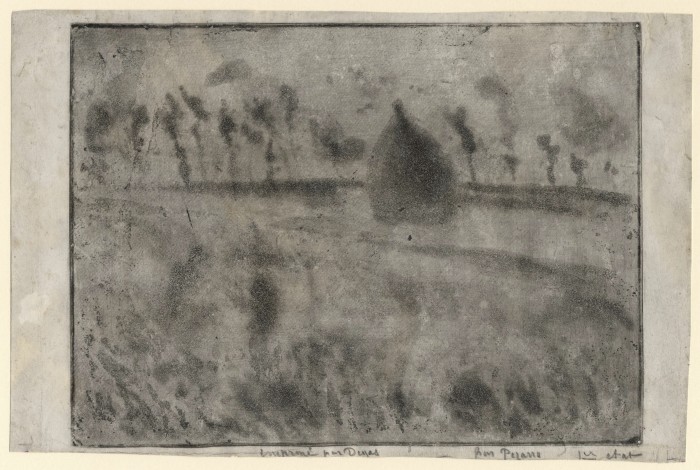Effet de Pluie – Effects of Rain 1879
Camille Pissarro
1830 St. Thomas – Éragny-sur-Epte 1903
Effet de Pluie – Effects of Rain 1879
pure aquatint on gray Japanese paper; 160 x 215 mm (6 1/4 x 8 1/2 inches)
inscribed in pencil below imprimé par Degas pour Pisarro (sic) 1er etat
Delteil 24 second state (of six)
comparative literature
Barbara Stern Shapiro, Camille Pissarro. The Impressionist Printmaker, exhibition catalogue, Museum of Fine Arts, Boston 1973, nos. 15–17 (states ii, iv, and vi); second, fourth, and sixth state); Nicole Minder, Degas & Pissarro: alchimie d’un rencontre, exhibition catalogue, Cabinet Cantonal des Estampes, Musée Jenisch, Vevey/Musée du Québec/The Israel Museum, Jerusalem 1998–99, Vevey 1998, cat. nos. 38–39 (states iii and iv).
There are some corrections to the list of known impressions recorded in the reprint of Delteil: We are able to trace two impressions of the first state (Bremen and formerly with C.G. Boerner [Neue Lagerliste 123, 2007, no. 37], now Minneapolis, but not Oxford); there is a second state in the Ashmolean Museum, Oxford, part of the Orovida Pissarro collection, printed on grayish paper, and another in the Yale University Art Gallery; to these, this impression, previously unrecorded, has to be added; there are two impressions of the third state (private collection in Switzerland and Frankfurt); two impressions of the fourth are in private collections (Switzerland and New York), the latter like ours annotated imprimé par Degas, as well as in Oxford and Philadelphia; there is one impression of the fifth state in Berlin.
Inspired by Degas and in anticipation of the new print journal Le jour et la nuit, Pissarro took up printmaking with a new enthusiasm in 1879. Like Degas and Cassatt, he experimented widely. The heavy, card-like wove paper of this early working proof matches the paper used by Degas for prints made at the same time. In the first two states Pissarro is laying the sort of liquid aquatint ground that Bracquemond had encouraged Degas to try, fully avoiding any use of drypoint or etching as a guide (the marks on the plate are either from polishing or accidents). The artist did not begin to articulate the composition with delicate drypoint lines before the third state; by the final state, etching and vernis mou (soft-ground), a metal brush and emery paper have all been employed in creating the composition.
This is a quintessential Impressionist print in an early stage of creation.
